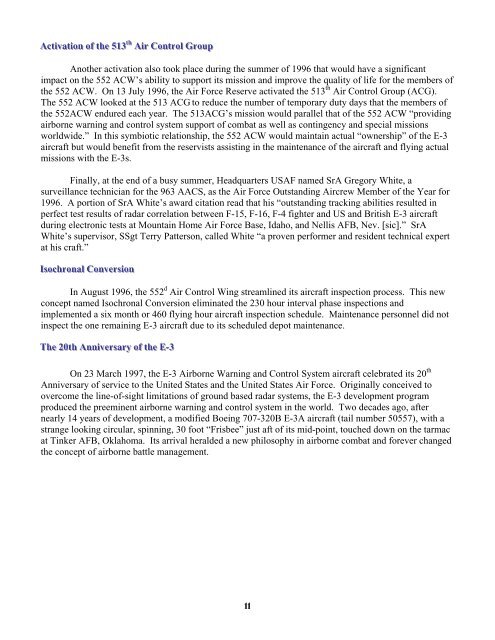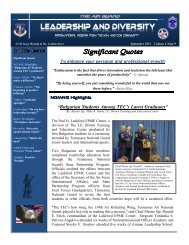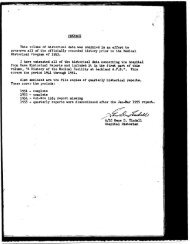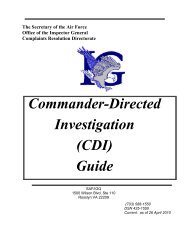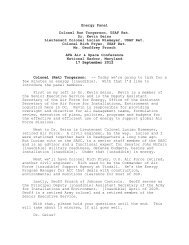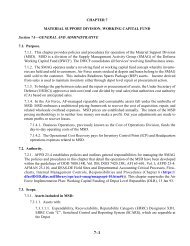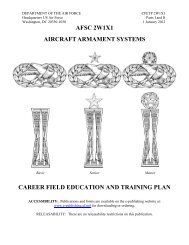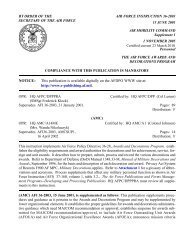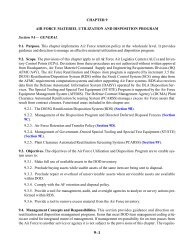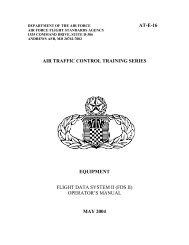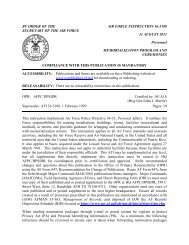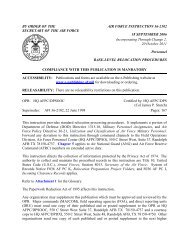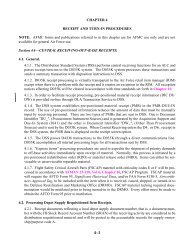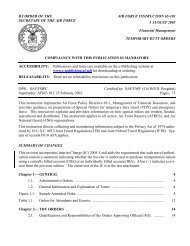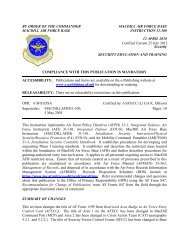Operational History of the 552 - Air Force Link
Operational History of the 552 - Air Force Link
Operational History of the 552 - Air Force Link
You also want an ePaper? Increase the reach of your titles
YUMPU automatically turns print PDFs into web optimized ePapers that Google loves.
Acct ti ivvaat ti ioonn<br />
o<strong>of</strong> f thhee t<br />
551133 th tth<br />
Ai irr Coonnt<br />
trrool l Grroouupp<br />
Ano<strong>the</strong>r activation also took place during <strong>the</strong> summer <strong>of</strong> 1996 that would have a significant<br />
impact on <strong>the</strong> <strong>552</strong> ACW’s ability to support its mission and improve <strong>the</strong> quality <strong>of</strong> life for <strong>the</strong> members <strong>of</strong><br />
<strong>the</strong> <strong>552</strong> ACW. On 13 July 1996, <strong>the</strong> <strong>Air</strong> <strong>Force</strong> Reserve activated <strong>the</strong> 513 th <strong>Air</strong> Control Group (ACG).<br />
The <strong>552</strong> ACW looked at <strong>the</strong> 513 ACG to reduce <strong>the</strong> number <strong>of</strong> temporary duty days that <strong>the</strong> members <strong>of</strong><br />
<strong>the</strong> <strong>552</strong>ACW endured each year. The 513ACG’s mission would parallel that <strong>of</strong> <strong>the</strong> <strong>552</strong> ACW “providing<br />
airborne warning and control system support <strong>of</strong> combat as well as contingency and special missions<br />
worldwide.” In this symbiotic relationship, <strong>the</strong> <strong>552</strong> ACW would maintain actual “ownership” <strong>of</strong> <strong>the</strong> E-3<br />
aircraft but would benefit from <strong>the</strong> reservists assisting in <strong>the</strong> maintenance <strong>of</strong> <strong>the</strong> aircraft and flying actual<br />
missions with <strong>the</strong> E-3s.<br />
Finally, at <strong>the</strong> end <strong>of</strong> a busy summer, Headquarters USAF named SrA Gregory White, a<br />
surveillance technician for <strong>the</strong> 963 AACS, as <strong>the</strong> <strong>Air</strong> <strong>Force</strong> Outstanding <strong>Air</strong>crew Member <strong>of</strong> <strong>the</strong> Year for<br />
1996. A portion <strong>of</strong> SrA White’s award citation read that his “outstanding tracking abilities resulted in<br />
perfect test results <strong>of</strong> radar correlation between F-15, F-16, F-4 fighter and US and British E-3 aircraft<br />
during electronic tests at Mountain Home <strong>Air</strong> <strong>Force</strong> Base, Idaho, and Nellis AFB, Nev. [sic].” SrA<br />
White’s supervisor, SSgt Terry Patterson, called White “a proven performer and resident technical expert<br />
at his craft.”<br />
IIssoocchhrroonnaal l Coonnvveerrssi ioonn<br />
In August 1996, <strong>the</strong> <strong>552</strong> d <strong>Air</strong> Control Wing streamlined its aircraft inspection process. This new<br />
concept named Isochronal Conversion eliminated <strong>the</strong> 230 hour interval phase inspections and<br />
implemented a six month or 460 flying hour aircraft inspection schedule. Maintenance personnel did not<br />
inspect <strong>the</strong> one remaining E-3 aircraft due to its scheduled depot maintenance.<br />
Thhee<br />
2200t thh Annnni ivveerrssaarryy<br />
o<strong>of</strong> f thhee t E- -33<br />
On 23 March 1997, <strong>the</strong> E-3 <strong>Air</strong>borne Warning and Control System aircraft celebrated its 20 th<br />
Anniversary <strong>of</strong> service to <strong>the</strong> United States and <strong>the</strong> United States <strong>Air</strong> <strong>Force</strong>. Originally conceived to<br />
overcome <strong>the</strong> line-<strong>of</strong>-sight limitations <strong>of</strong> ground based radar systems, <strong>the</strong> E-3 development program<br />
produced <strong>the</strong> preeminent airborne warning and control system in <strong>the</strong> world. Two decades ago, after<br />
nearly 14 years <strong>of</strong> development, a modified Boeing 707-320B E-3A aircraft (tail number 50557), with a<br />
strange looking circular, spinning, 30 foot “Frisbee” just aft <strong>of</strong> its mid-point, touched down on <strong>the</strong> tarmac<br />
at Tinker AFB, Oklahoma. Its arrival heralded a new philosophy in airborne combat and forever changed<br />
<strong>the</strong> concept <strong>of</strong> airborne battle management.<br />
11


